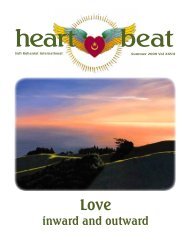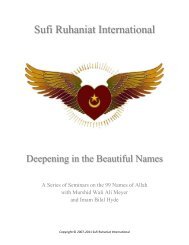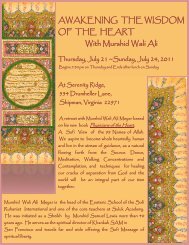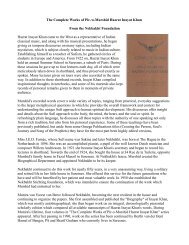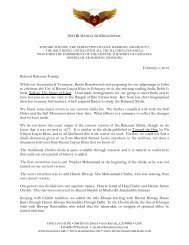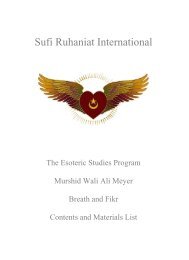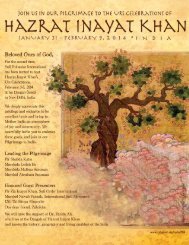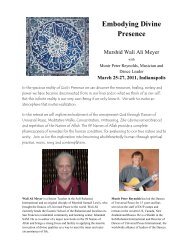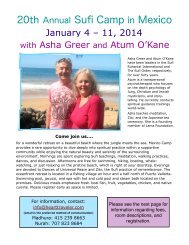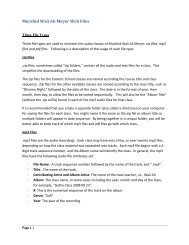HeartBeat Magazine: The Edge of Life - Sufi Ruhaniat International
HeartBeat Magazine: The Edge of Life - Sufi Ruhaniat International
HeartBeat Magazine: The Edge of Life - Sufi Ruhaniat International
You also want an ePaper? Increase the reach of your titles
YUMPU automatically turns print PDFs into web optimized ePapers that Google loves.
Facing Death<br />
by Ram Dass<br />
Remember friend,<br />
as you pass by,<br />
as you are now,<br />
so once was I.<br />
As I am now,<br />
so you must be.<br />
Prepare yourself<br />
to follow me.<br />
—Tombstone in<br />
Ashby, Massachusetts<br />
Something has happened to me as a result <strong>of</strong> meandering<br />
through many realms <strong>of</strong> consciousness over the<br />
past 50 years that has changed my attitude toward<br />
death. A lot <strong>of</strong> the fear about death has gone from me.<br />
I am someone who actually delights in being with<br />
people as they are dying. It is such incredible grace<br />
for me. In the morning, if I know I am going to be<br />
with such a person, I get absolutely thrilled because I<br />
know I am going to have an opportunity to be in the<br />
presence <strong>of</strong> Truth.<br />
It is now becoming acceptable in our culture for people<br />
to die. For many decades, death was kept behind<br />
closed doors. But now we are allowing it to come out<br />
into the open. Having grown up in this culture, the<br />
first few months I spent in India in the 1960s were<br />
quite an experience. <strong>The</strong>re, when someone dies, the<br />
body is placed on a pallet, wrapped in a sheet, and<br />
carried through the streets to the burning grounds<br />
while a mantra is chanted. Death is out in the open<br />
for everyone to see. <strong>The</strong> body is right there. It isn’t in<br />
a box. It isn’t hidden. And because India is a culture <strong>of</strong><br />
extended families, most people are dying at home. So<br />
most people, as they grow up, have been in the presence<br />
<strong>of</strong> someone dying. <strong>The</strong>y haven’t walked away<br />
from it and hidden from it as we have in the West.<br />
I was certainly one <strong>of</strong> the people in this culture who<br />
hid from death. But over the past few decades I have<br />
changed dramatically. <strong>The</strong> initial change came as a<br />
result <strong>of</strong> my experiences with psychedelic chemicals. I<br />
came into contact with a part <strong>of</strong> my being that I had not<br />
identified with in my adult life. I was a Western psychologist,<br />
a pr<strong>of</strong>essor at Harvard, and a philosophical<br />
materialist. What I experienced through psychedelics<br />
was extremely confusing, because there was nothing in<br />
6 <strong>HeartBeat</strong> Winter 2011<br />
my background that prepared me to deal with another<br />
component <strong>of</strong> my being. Once I started to experience<br />
myself as a “Being <strong>of</strong> Consciousness”—rather than as<br />
a psychologist, or as a conglomerate <strong>of</strong> social roles, the<br />
experience pr<strong>of</strong>oundly changed the nature <strong>of</strong> my life.<br />
It changed who I thought I was.<br />
Prior to my first experience with psychedelics, I had<br />
identified with that which dies—the ego. <strong>The</strong> ego is<br />
who I think I am. Now, I identify much more with who<br />
I really am—the Soul. As long as you identify with<br />
that which dies, there is always fear <strong>of</strong> death. What our<br />
ego fears is the cessation <strong>of</strong> its own existence. Although<br />
I didn’t know what form it would take after death, I<br />
realized that the essence <strong>of</strong> my Being—and the essence<br />
<strong>of</strong> my awareness—is beyond death.<br />
<strong>The</strong> interesting thing to me at the time was that my<br />
first experience with psychedelics was absolutely indescribable.<br />
I had no concepts to apply to what I was<br />
finding in my own being. <strong>The</strong>n, Aldous Huxley gave<br />
me a copy <strong>of</strong> <strong>The</strong> Tibetan Book <strong>of</strong> the Dead. As I read<br />
it, I was amazed to find myself reading lucid, clearly<br />
articulated descriptions <strong>of</strong> the very experiences I was<br />
having with psychedelics. It was immensely confusing<br />
to me because <strong>The</strong> Tibetan Book <strong>of</strong> the Dead is 2,500 years<br />
old. I had thought, in 1961, that I was at the leading<br />
edge <strong>of</strong> the unknown. But here was an ancient text<br />
revealing that Tibetan Buddhists already knew—2,500<br />
years ago—everything I had just learned.<br />
<strong>The</strong> Tibetan Book <strong>of</strong> the Dead was used by Tibetan Buddhist<br />
lamas to read to fellow lamas, as they were dying<br />
and for 49 days after their death. Tim Leary, Ralph<br />
Metzner, and I began to see the book in metaphorical<br />
>>



